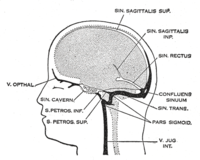
Photo from wikipedia
BACKGROUND AND AIMS Recent non-malignant non-cirrhotic portal venous system thrombosis (PVT) is a rare condition. Among risk factors for PVT, cytomegalovirus (CMV) disease is usually listed based on few reported… Click to show full abstract
BACKGROUND AND AIMS Recent non-malignant non-cirrhotic portal venous system thrombosis (PVT) is a rare condition. Among risk factors for PVT, cytomegalovirus (CMV) disease is usually listed based on few reported cases. The aim of this study was to determine characteristics and outcome of patients with PVT associated with CMV disease. METHODS We conducted a French multicenter retrospective study comparing patients with recent PVT and CMV disease ("CMV positive"; n = 23) with patients with recent PVT for whom CMV testing was negative ("CMV negative"; n = 53) or unavailable ("CMV unknown"; n = 297). RESULTS As compared with patients from the "CMV negative" and "CMV unknown" groups, patients from the "CMV positive" group were younger, had more frequently fever, higher heart rate, higher lymphocyte count and higher serum ALT levels (p ≤ 0.01 for all). Prevalence of immunosuppression did not differ between the 3 groups (4%, 4% and 6%, respectively). Extension of PVT was similar between the 3 groups. Thirteen out of 23 "CMV positive" patients had another risk factor for thrombosis. Besides CMV disease, number of risk factors for thrombosis was similar between the 3 groups. Heterozygous prothrombin gene mutation was more frequent in "CMV positive" patients (22%) than in the "CMV negative" (4%, p = 0.01) and "CMV unknown" (8%, p = 0.03) groups. Recanalization rate was not influenced by CMV status. CONCLUSIONS In patients with recent PVT, features of mononucleosis syndrome should raise suspicion of CMV disease. CMV disease does not influence thrombosis extension nor recanalization. More than half "CMV positive" patients have another risk factor for thrombosis, with a particular link with prothrombin gene mutation. LAY SUMMARY Patients with CMV-associated portal venous system thrombosis have similar thrombosis extension and evolution as patients without CMV disease. They more frequently have prothrombin gene mutation, suggesting a synergy between these two entities to promote thrombosis.
Journal Title: Journal of hepatology
Year Published: 2021
Link to full text (if available)
Share on Social Media: Sign Up to like & get
recommendations!